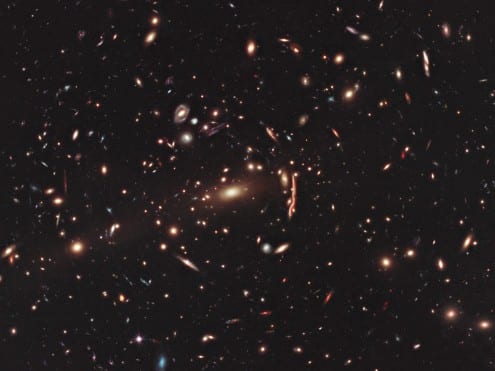UCL’s science with the Hubble Space Telescope
By Oli Usher, on 22 April 2015
This is the second in a series of posts marking the 25th anniversary of the Hubble Space Telescope. Read the first here.
UCL astronomers have been involved with the full range of Hubble science over the years.
Here are just a few highlights.
Detecting the first organic molecule on an extrasolar planet

Artist’s impression of HD 189733b passing in front of its star. The small amount of starlight that passes through the planet’s atmosphere carries with it the fingerprint of the gases present there. Credit: ESA/Hubble (Martin Kornmesser)
In 2008, a team including UCL’s Giovanna Tinetti (now working on the proposed Twinkle mission) made the first detection of an organic molecule on a planet outside the Solar System, using Hubble. Organic molecules – ones based on carbon – are thought to play a key role in the emergence of complex chemistry and the appearance of life.
Although this planet, known as HD 189733b, is so hot that it is almost certainly sterile, the team proved it has traces of methane in its atmosphere. This shows not only that organic molecules exist outside our Solar System, but that they can be detected from Earth – and that one day we might detect signs of life on another planet using the same methods.
Hubble observed the light coming from HD 189733b’s parent star as the planet passed between Hubble and the star. The gases in the atmosphere leave a faint fingerprint in the light that passes through the atmosphere, letting the scientists deduce what gases were present.
Understanding the superwinds of Messier 82

Composite image of Hubble and WIYN observations of M 82. Credit: Mark Westmoquette (University College London), Jay Gallagher (University of Wisconsin-Madison), Linda Smith (University College London), WIYN//NSF, NASA/ESA
Messier 82 (or M 82 for short) is a peculiar-looking galaxy – in the news last year thanks to a UCL lecturer and his students discovering a bright supernova there. It is in the midst of a sustained period of star formation known to astronomers as a ‘starburst’ – and this has dramatic effects on the appearance of the galaxy. It shines brightly with bright blue newly-formed stars, with noticeable regions of disrupted gas and dust clouds. It is an easy and popular target for amateur astronomers to find with mid-sized telescopes.
But the most dramatic aspect of M 82’s appearance has to be the powerul winds of glowing gas ejected out of the galaxy.
In 2004, a team of scientists including Linda Smith and Mark Westmoquette (both then at UCL) used archival Hubble images, alongside images from the WIYN telescope, to trace these ‘superwinds’. They found multiple streams of gas expanding at different rates, creating a shower of hot gas expelled from the galaxy. Some of these were travelling at more than a million miles per hour.
The team believes that the burst of star formation was triggered by a near-miss with nearby spiral galaxy M 81, which disrupted the gas clouds in M 82.
Probing the dark universe using galaxy clusters
The discovery of the accelerating expansion of the Universe was one of the most startling scientific breakthroughs of the past century. Astronomers had long known that the universe was expanding, but assumed that this expansion was gradually slowing over time. Instead, in 1998, two teams of astronomers discovered that the universe’s expansion is speeding up, with an unknown force they call dark energy driving it.
The amount of energy involved in this mysterious process is enormous – calculations show it makes up around three quarters of the total mass and energy content of the universe. This is on top of dark matter – matter whose gravity can be seen, but which is totally invisible to telescopes – which also outweighs all the ordinary matter in the universe. This means that the matter we can actually see – stars, planets, nebulae, dust clouds, galaxies – only makes up about one part in 20 of the whole universe. The rest is dark; it neither emits, reflects nor absorbs light.
A team of astronomers including UCL’s Ofer Lahav proposed to carry out a huge programme of observations called the Cluster Lensing and Supernova Survey with Hubble (CLASH), in order to gather as much data as possible about the mysteries of the dark universe.

Cluster MACSJ1206, one of 25 observed by the CLASH programme. The distorted, magnified shapes of background galaxies can be faintly seen in the image. Credit: NASA, ESA, the CLASH team and Marc Postman
Between 2010 and 2013, the survey made detailed images of 25 massive galaxy clusters. These clusters, which are among the largest structures in the universe, have so much gravity – largely thanks to the dark matter they contain – that they warp space-time. This means that they bend the path of light that passes through them, in a similar way to a lens.
The lensing of light reveals the location of dark matter, which is otherwise invisible. It also amplifies the light coming from galaxies in the background, enabling astronomers to see distant supernovae that would otherwise be too faint to observe. The apparent brightness of these supernovae is one of astronomers’ key tools for measuring the expansion rate of the universe, and hence the nature of dark energy.
UCL’s work in CLASH has focused on ‘photometric redshifts’, a means of deducing the distance of faraway galaxies from the colour profile they have. This work was led by Ofer Lahav, along with researchers Stephanie Jouvel and Ole Host.
On Friday, the UCL Science blog will explain what comes next for the ageing space telescope – and how UCL is helping to build its successor.
 Close
Close


